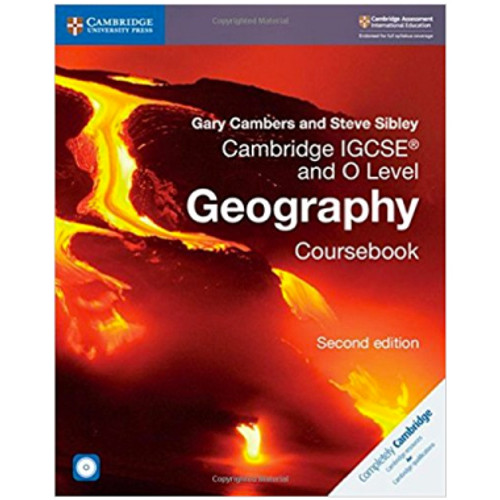Cambridge IGCSE and O Level Geography Digital Coursebook (2 Years)
Author/s: Gary Cambers and Steve Sibley
Filled with sources, graphs and case studies, the coursebook requires students to examine a range of information, helping to build their analytical skills.
Written by highly experienced authors and Cambridge trainers, this coursebook is updated to support both Cambridge IGCSE and O Level students.
It includes clear and practical support, case studies from 25 different countries, fieldwork ideas and a range of interesting content.
Also included are support sheets for the topics covered, outline maps and sample exam-style questions.
Answers to the activities are in the teacher's resource.
Features:
- 50 up-to-date case studies from 25 countries, including many with Cambridge International centers.
- A range of attractive content, including over 400 illustrations, helps capture and keep students’ imagination.
- Each spread of the book amounts to one lesson, making content easy to follow because information is all in one place.
- Fieldwork ideas for theoretical and practical use.
- Full coverage of the Cambridge IGCSE and O Level Geography syllabuses.
- The accompanying CD-ROM contains over 40 support sheets for use with topics in the coursebook, and over 30 sample exam-style questions on geographical themes with marking schemes.
Contents:
Part A. Geographical Themes: World map
Theme 1. Population and Settlement: 1. World population increase
2. Over-population and under-population
Case Study. Over-population–Nigeria
Case Study. Under-population–Australia
3. Causes of a change in population size
4. Population change
Case Study. High rate of natural population growth–Niger
Case Study. Population decline–Russia
5. Population policies
6. Population migration
7. The impacts of migration
Case Study. An international migration–Qatar
8. Finding out about the population
Case Study. A country with high dependency–Italy
9. Factors influencing population density
Case Study. High population density–Japan
Case Study. Low population density–Namibia
10. Settlement patterns
11. Settlement sites, growth and functions
12. Settlement hierarchy
Case Study. Settlement and service provision in Sardinia
13. Urban land use
14. Urban problems and solutions
Case Study. An urban area–Atlanta
15. Rapid urban growth
16. Impacts of urban growth
Case Study. Urbanisation in Peru–Lima
Exam-style questions
Global Theme 1. HIV/AIDS
Theme 2. The Natural Environment: 17. Types and features of earthquakes and volcanoes
18. Plate tectonics
19. Causes and effects of earthquakes and volcanoes
20. Volcanoes present hazards and opportunities
21. Reducing the impacts
Case Study: An earthquake–Haiti
Case Study. A volcano–Mount Sinabung
22. Rivers and drainage basins
23. The work of rivers
24. River landforms 1
25. River landforms 2
26. Rivers–hazards and opportunities
27. Managing river flooding
Case Study. The Elbe River
28. The work of the sea
29. Coastal landforms created by erosion
30. Coastal landforms created by deposition
31. Coral reefs and mangrove swamps
32. Hazards and opportunities
33. Managing coastal erosion
Case Study. An area of coastline–Mauritius
34. Collecting weather data 1
35. Collecting weather data 2
36. Using weather data
37. Using weather and climate data
38. The equatorial climate
39. Tropical rainforest ecosystems
40. Rainforest deforestation
Case Study. The tropical rainforest–Ecuador
41. Hot desert climates
42. Hot desert ecosystems
Case Study. A hot desert–the Sahara and Mali
Exam-style questions
Global Theme 2. Reducing Carbon Emissions
Theme 3. Economic Development: 43. Indicators of development
44. Identifying inequalities
45. Classifying production
46. Employment structure varies
47. Globalisation
Case Study. A trans-national corporation–Nokia
48. Agricultural systems
Case Study. An arable farm in Lincolnshire
49. Food shortages
Case Study. Food shortages in Darfur, Sudan
50. Industrial systems
51. Industrial location
Case Study. The Pakistan steel complex at Pipri
52. The growth of tourism
53. The benefits and disadvantages of tourism
54. Managing Tourism for sustainability
Case Study. An area where tourism is important–Dubai, UAE
55. Energy use varies
56. Nuclear power or renewables
Case Study. Energy supply in Iceland
57. Using water
58. Managing water
Case Study. Water supply in Lesotho
59. Economic activities pose threats
60. Managing sustainable development
61. Conserving natural resources
Case Study. Fracking in California
Exam-style questions
Global Theme 3. Reduce, reuse, recycle
Part B. Geographical Skills: 1. 1:50 000 Monsefu, Peru
2. 1:50 000 Harare, Zimbabwe
3. 1:25 000 North York Moors, UK
4. 1:25 000 Montego Bay, Jamaica
5. 1:25 000 Negara, Indonesia
6. 1:50 000 Leicester, UK
Exam-style questions
Map skills checklist
Part C. Geographic Enquiry: Fieldwork skills examinations
1. Investigating the CBD
2. Investigating rivers
3. Investigating tourism
4. Investigating weather
Fieldwork checklist
The alternatives to coursework
Exam-style question 1
Exam-style question 2
Part D. Preparing for Examinations: Geographical themes: Case studies
Geographical skills
Alternative to coursework/Geographical investigation
Resource.






